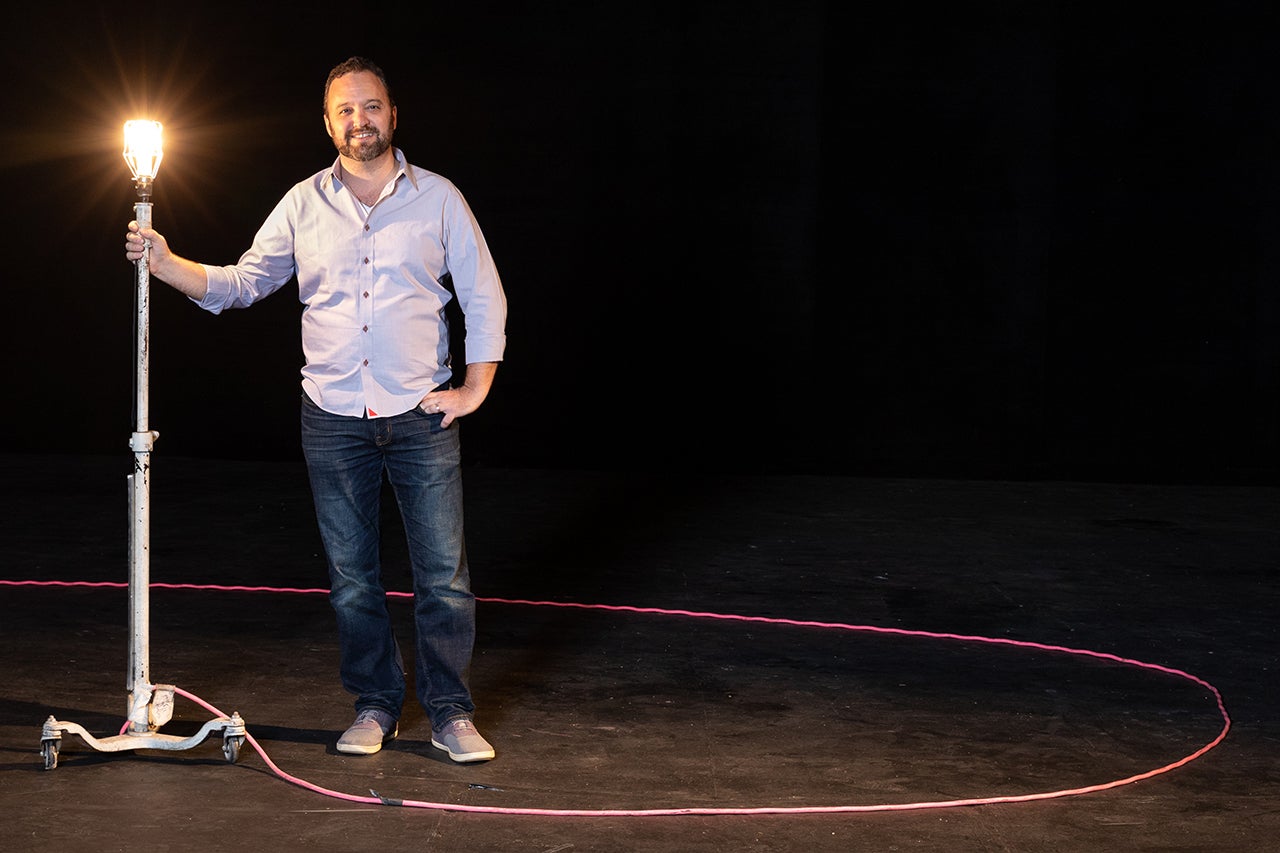As an award-winning lighting designer on and off Broadway, Jason Lyons has made a career of creating scenes that transport and inspire audiences. And now, as the visiting light designer and theater instructor in the College of Charleston School of the Arts, he is inspiring a different kind of audience, bringing his students’ passions to light and helping them shine.
Lyons, whose Broadway credits include On the Town, Bronx Bombers and Barefoot in the Park, is well-known across the country; he is even one of the designers that CofC theater students have researched and studied. When he moved from NYC to Charleston in search of a better work-life balance last year, Lyons first came to the College as a guest speaker in the Department of Theatre and Dance. Now that he is teaching Stage Lighting, Fundamentals of Theatre Design, Advanced Problems in Design, Career Seminar for Designers and Technicians, among other special topics courses about the professional theater world, students are working with him much more closely. He will serve as the lighting designer for The Addams Family musical in April, as well.
The College Today recently caught up with Lyons, who shed some light on his accomplished career in lighting design and his new role at the College of Charleston.
How did you get interested in lighting design?
I started in high school as a performer. Our director asked me if I’d be interested in interning at a summer stock theater where he was working. I spent the summer working backstage in all of the different trades that are involved, ending in running followspot [or spotlight] for a show. As I watched the show every night and noted how the lighting cues created dynamic settings and helped shape the mood for the audience, I fell in love with the notion of being able to transport and inspire without them necessarily realizing it.
What, exactly, does a lighting designer do?
As lighting designers, we help create the world of the play, with the ability to shift mood, location or time of day. We can shift the stage from sunset in a lush garden to an isolated jail cell with a simple shift in lighting. We support and sometimes enhance the story/dance/music/idea. We can add dynamics that help build excitement or focus that pulls the onlookers to the edge of their seats. The point of view we bring to the table creates the lens through which the audience sees the play.
Describe your creative process – where do get your inspiration, and how do you translate that into light?
I tend to be inspired by things that illicit an emotional response. This can come from art, music, photographs or even driving across the bridge at just the right point of sunset. I try to look for things in everyday life that would be easily relatable to our audiences. I can then take those experiences and translate them to the stage in light.
What is the coolest project you’ve worked on, and what made it so special?
It’s hard to say, because there’s part of you that has to fall in love with certain aspects of every project you take on. I’ve had the joy of making big splashy new musicals, intimate, dark and twisted plays and fresh takes on classic shows, and every one of them has been a challenge and a wonder.
Each show is unique, as is each creative team. I’ve also had the wonderful opportunity of being able to work with countless collaborators on hundreds of productions over the last 20 years. It’s a constantly shifting, challenging, rewarding sharing and learning experience. I’m able to be at the top of my field and still learn and grow with every new collaboration.
What is your proudest achievement?
My son Finn.
When you watch a Broadway production, what do you see that most of us don’t even notice?
I try to go see shows from an audience’s perspective and put aside that I know “how the sausage is made.” If I watch everything dissecting its design and structure, then I don’t ever get to enjoy theater, and it’s all only work.
Speaking of work, what has it been like teaching at the College of Charleston?
I feel like between the city and the College itself, I am constantly surprised by the bits of beauty that I discover in every corner. I keep reminding my students to not take their surroundings for granted, as there is so much to take in and be inspired by. It’s been several years since I last taught, and spending time with the students here has reinvigorated both my passion for the work I do, as well as my excitement to share it with young artists.
What do you hope your students take away from your classes?
My hope in exploring design with students is that they find a passion in how to integrate who they are and their own artistic voice into how they tell stories and convey mood. Every person brings a very unique point of view to any project, and realizing that power carries a great excitement and responsibility.
Any final words of wisdom for your students and other aspiring lighting designers out there?
Always be learning, looking and listening.




